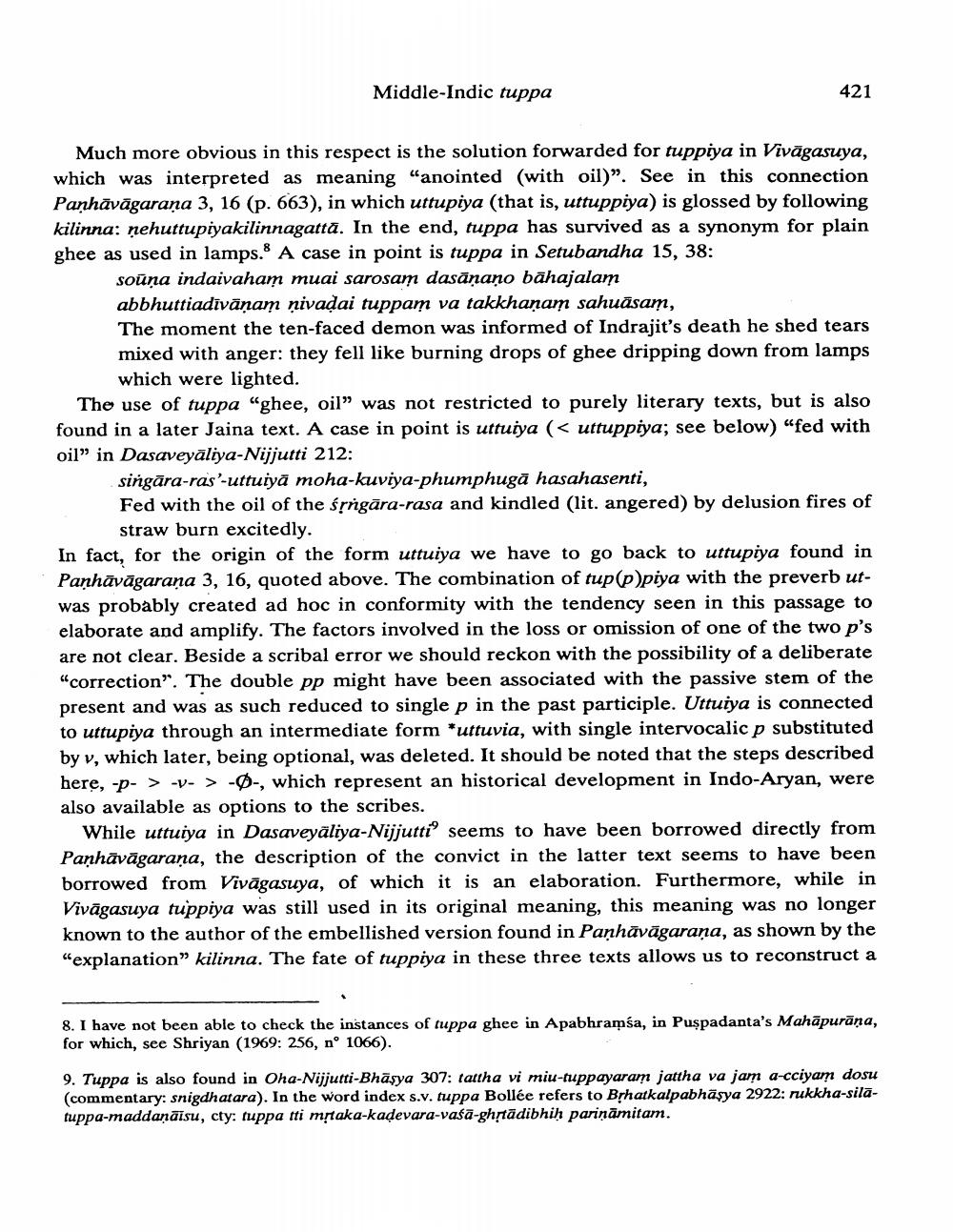________________
Middle-Indic tuppa
421
Much more obvious in this respect is the solution forwarded for tuppiya in Vivāgasuya, which was interpreted as meaning "anointed (with oil)". See in this connection Paṇhāvāgarana 3, 16 (p. 663), in which uttupiya (that is, uttuppiya) is glossed by following kilinna: ņehuttupiyakilinnagatta. In the end, tuppa has survived as a synonym for plain ghee as used in lamps. A case in point is tuppa in Setubandha 15, 38:
soūņa indaivaham muai sarosam dasānano bāhajalam abbhuttiadīvānam ņivaļai tuppam va takkhanam sahuāsam, The moment the ten-faced demon was informed of Indrajit's death he shed tears mixed with anger: they fell like burning drops of ghee dripping down from lamps
which were lighted. The use of tuppa "ghee, oil” was not restricted to purely literary texts, but is also found in a later Jaina text. A case in point is uttuiya (< uttuppiya; see below) "fed with oil” in Dasaveyaliya-Nijjutti 212:
singāra-ras'-uttuiyā moha-kuviya-phumphugā hasahasenti, Fed with the oil of the śrngāra-rasa and kindled (lit. angered) by delusion fires of
straw burn excitedly. In fact, for the origin of the form uttuiya we have to go back to uttupiya found in Panhāvāgaraņa 3, 16, quoted above. The combination of tup(p)piya with the preverb utwas probably created ad hoc in conformity with the tendency seen in this passage to elaborate and amplify. The factors involved in the loss or omission of one of the two p's are not clear. Beside a scribal error we should reckon with the possibility of a deliberate "correction". The double pp might have been associated with the passive stem of the present and was as such reduced to single p in the past participle. Uttuiya is connected to uttupiya through an intermediate form *uttuvia, with single intervocalic p substituted by v, which later, being optional, was deleted. It should be noted that the steps described here, -p- > -v- > --, which represent an historical development in Indo-Aryan, were also available as options to the scribes.
While uttuiya in Dasaveyāliya-Nijjutti' seems to have been borrowed directly from Panhāvāgarana, the description of the convict in the latter text seems to have been borrowed from Vivāgasuya, of which it is an elaboration. Furthermore, while in Vivāgasuya tuppiya was still used in its original meaning, this meaning was no longer known to the author of the embellished version found in Panhāvāgaraņa, as shown by the "explanation” kilinna. The fate of tuppiya in these three texts allows us to reconstruct a
8. I have not been able to check the instances of tuppa ghee in Apabhramsa, in Puspadanta's Mahāpurana, for which, see Shriyan (1969: 256, n° 1066).
9. Tuppa is also found in Oha-Nijjutti-Bhāsya 307: tattha vi miu-tuppayaram jattha va jam a-cciyam dosu (commentary: snigdhatara). In the word index s.v. tuppa Bollée refers to Brhatkalpabhäsya 2922: rukkha-silatuppa-maddanisu, cty: tuppa tti mstaka-kadevara-vasā-ghstādibhih parināmitam.




